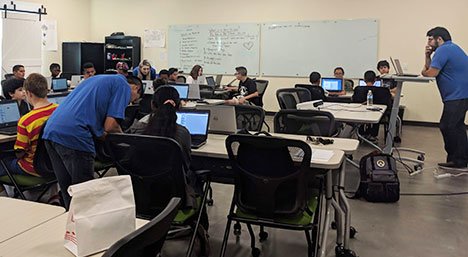Best Online Platforms for K-12 Students in the U.S.
Discover the best online platforms for K-12 students in the U.S. interactive adaptive tools for math coding languages and core subjects Boost learning today.

The best online platforms for K-12 students in the U.S. have transformed modern education by providing accessible, engaging, and personalized learning experiences. With the rise of digital classrooms and hybrid learning models, these platforms offer interactive lessons, real-time feedback, and adaptive curricula that cater to diverse learning styles. From core subjects like mathematics and language arts to specialized courses in coding and the arts, these tools empower students to learn at their own pace while supplementing traditional classroom instruction.
As technology continues to evolve, the demand for high-quality online learning resources has grown exponentially. The best online platforms for K-12 students in the U.S. not only support academic success but also foster critical thinking, creativity, and independent learning. Whether used for remediation, enrichment, or skill development, these digital solutions provide students, parents, and educators with the tools needed to thrive in an increasingly digital educational landscape. This guide explores the top platforms available today, highlighting their unique features and benefits for learners of all ages.
Best Online Platforms for K-12 Students in the U.S.
Khan Academy
Khan Academy remains one of the most widely used free online learning platforms for K-12 students. It covers subjects such as math, science, history, and economics through video lessons, practice exercises, and personalized learning dashboards. The platform is particularly beneficial for students who need additional support outside the classroom, as it provides step-by-step explanations and progress tracking.
IXL Learning
Adaptive Skill Development
IXL’s smart algorithm continuously adjusts question difficulty based on real-time performance, providing targeted practice in math, language arts, science, and social studies. The platform breaks each subject into micro-skills, offering explanations for incorrect answers and progressively challenging students as they demonstrate mastery. This granular approach ensures learners stay in their optimal zone of development without frustration or boredom.
Actionable Data Insights
Teachers and parents gain access to detailed reports highlighting student progress, time-on-task, trouble spots, and skill proficiency levels. The real-time Online Platforms dashboard identifies class-wide trends and individual knowledge gaps, enabling data-driven instruction. With alignment to all 50 state standards, IXL transforms raw performance metrics into concrete next steps for intervention or enrichment.
Outschool
Unlike traditional e-learning platforms, Outschool focuses on live, small-group classes taught by independent educators. Students can explore a wide range of Online Platforms, from academic topics like algebra and chemistry to creative pursuits like creative writing and digital art. This platform is ideal for learners who thrive in interactive, discussion-based environments.
Prodigy Math
Prodigy Math gamifies math learning for students in grades 1-8, turning problem-solving into an engaging adventure. The platform aligns with Common Core and state standards, making it a useful supplement to school curricula. Online Platforms can also assign specific skills for students to practice, ensuring targeted learning.
Duolingo for Schools
Gamified Learning Experience
Duolingo for Schools turns language acquisition into an engaging adventure through interactive exercises, rewards, and progress tracking. The platform uses bite-sized lessons, colorful visuals, and playful challenges to keep students motivated. Features like streaks, XP points, and leaderboards encourage consistent practice, while immediate feedback helps learners correct Online Platforms in real time. This approach makes mastering a new language feel more like a game than traditional study, increasing student participation and retention.
Teacher Tools and Progress Monitoring
Educators benefit from Duolingo’s classroom integration, which allows them to assign specific lessons, track student progress, and identify areas needing improvement. The platform provides detailed reports on vocabulary retention, grammar mastery, and overall Online Platforms, helping teachers tailor instruction to individual needs. Since Duolingo supports multiple languages from Spanish and French to less commonly taught options like Arabic and Japanese it serves as a versatile supplement to school curricula, whether for beginner learners or advanced students refining their fluency.
Coursera and edX for Advanced Learners
For high school students seeking advanced coursework, platforms like Coursera and edX offer college-level classes from top universities. These Online Platforms can provide a head start on higher education and help students explore potential career paths.
ABCmouse and Adventure Academy for Younger Students
ABCmouse offers a step-by-step curriculum for preschoolers with 10,000+ activities, while Adventure Academy provides immersive 3D worlds for older Online Platforms to explore math, language arts, and science concepts. Parents and teachers can monitor skill mastery through detailed dashboards, while motivational systems (tickets, virtual pets) keep young learners consistently engaged.
Google Classroom and Canvas for School Integration
Centralized Learning Management Systems
Both Google Classroom and Canvas serve as comprehensive digital hubs that consolidate assignments, course materials, and student-teacher Online Platforms in one accessible platform. Google Classroom integrates seamlessly with G Suite tools (Docs, Slides, Sheets) for real-time collaboration, while Canvas offers robust features like discussion boards, quizzes, and Online Platforms content integration. These platforms eliminate paperwork, reduce organizational overhead, and provide 24/7 access to learning resources, making them indispensable.
Powerful Integration and Analytics Capabilities
What sets these platforms apart is their ability to integrate with hundreds of educational apps (like Turnitin, Zoom, and Khan Academy) while maintaining a unified gradebook and assignment workflow. Canvas particularly excels with its advanced analytics Online Platforms that helps teachers identify struggling students through engagement metrics and performance trends. Both systems support automated grading for certain assignment types, rubric-based assessments, and parent portals.
Code.org and Tynker for Coding Education
Code.org uses block-based programming and popular themes (Minecraft, Star Wars) to teach computational thinking, while Tynker offers progressive courses from block coding to Python/JavaScript. Both platforms feature creative studios where students build Online Platforms, apps, and animations, applying coding concepts to tangible projects that boost problem-solving skills.
BrainPOP
BrainPOP delivers complex concepts through lively, cartoon-style videos that make learning enjoyable and accessible for visual learners across K-12 grades. Each Online Platforms is paired with graded quizzes, concept maps, and creative activities that reinforce understanding while allowing educators to track progress. The platform offers standards-matched content in core subjects (STEM, social studies, English) plus supplemental topics like digital citizenship and financial literacy.
Read More: Coping with Exam Anxiety Wellness Tips That Work
Conclusion
The best online platforms for K-12 students in the U.S. have revolutionized education by offering flexible, engaging, and personalized learning experiences. From interactive math games to live virtual classrooms, these tools provide students with the resources they need to succeed academically while catering to different learning styles. Whether used as a supplement to traditional schooling or for independent study, these platforms help bridge learning gaps, reinforce key concepts, and keep students motivated.
As technology continues to advance, the role of digital learning in K-12 education will only grow stronger. The best online platforms for K-12 students in the U.S. empower both educators and parents to track progress, customize lessons, and foster a lifelong love of learning. By choosing the right platform based on individual needs and goals, students can enhance their skills, explore new subjects, and prepare for future academic success in an increasingly digital world.
FAQs
What is the best free online learning platform for K-12 students?
Khan Academy is one of the best free platforms, offering comprehensive lessons in math, science, and humanities for all grade levels.
Which platform is best for interactive live classes?
Outschool provides live, small-group classes on a variety of subjects, making learning interactive and engaging.
Are there online platforms for advanced high school students?
Yes, Coursera and edX offer college-level courses from top universities, ideal for high school students seeking advanced learning.
How can younger students benefit from online learning?
Platforms like ABCmouse and Adventure Academy use games and Online Platforms to teach foundational skills in a fun, engaging way.
Do schools integrate online learning platforms?
Many schools use Google Classroom or Canvas to manage assignments, communication, and grading in a centralized digital space.







